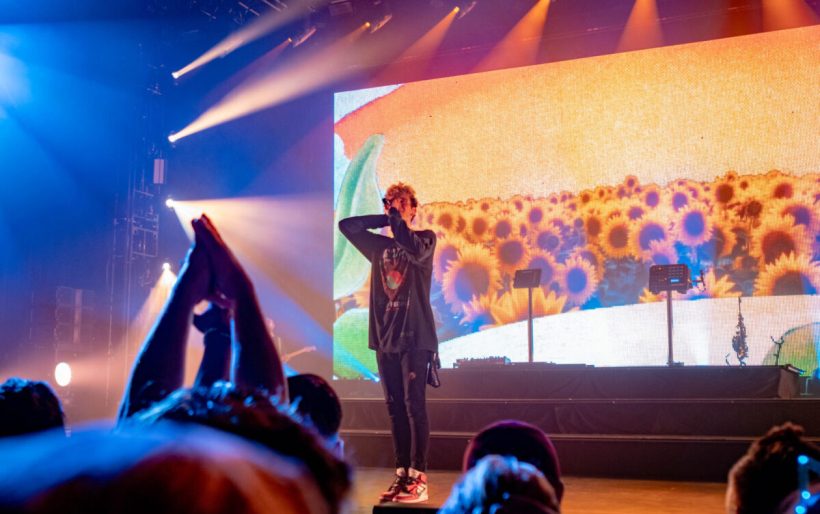
GRiZ | photo by Emily DeHart for WXPN
The wave-riding GRiZ fills The Met Philly with stimulating energy
Since breaking out all the way back in 2013, GRiZ has continued to raise the bar for combining electronic, jazz, dubstep, and funk sounds. This is surely not a combination that most take on the task of creating, but he’s made it work at festivals like Electric Forest, Lollapalooza, and Bonnaroo. His headlining tours are the best exemplification of his distinct talent, though, and we saw that when his Ride Waves tour came to The Met on Saturday.
Starting the show off with an dazzling set of strobing white lights, GRiZ’s silhouette appeared on stage with an intensity like no other. His presence on stage ignited the electricity in the audience, filling the room with stimulating energy.

GRiZ | photo by Emily DeHart for WXPN
GRiZ is especially known for his incorporation of saxophone in his production, and also blends elements of hip-hop into tracks on his new 14-track album Ride Waves. In order to do this, he collaborated with artists such as Wiz Khalifa, DRAM, Snoop Dogg, and Bootsy Collins. This collaboration was no surprise because of GRiZ’s reputation for genre integration, but what was indeed a surprise was his very own vocals in two tracks that were released in November 2018. After a extensive social media detox, he released “It Gets Better” and “Can’t Get Enough”. When he played The Met, these songs sung in his own voice created a new connection, a sense of community that grabbed the audience.
Riding waves encourages the ability to experience the highs and lows of life with grace and acceptance. Just as waves come and go, so do the excruciating lows and the tremendous highs. Knowing that all emotions and feelings are temporary, GRiZ embodies the notion that you must let these sentiments come and go peacefully — just as a wave does.

GRiZ | photo by Emily DeHart for WXPN
The performance of “It Gets Better” was one of the most heartfelt and powerful parts of the night. The awareness of this important theme of riding a wave was understood by the audience on a profound level. GRiZ was able to find and empower the root of what it means to be human: to feel. He took this and guided the audience to emotionally sing the loudest they have that whole night. The emotions of agony and bliss from the turmoils of life poured out of not only GRiZ, but also out of the listeners.
Actually, let me correct that: they were not simply listeners. They were not simply an audience. They were not simply fans — and GRiZ was not simply an artist they just came to see. He was not simply a performer. He was not simply a producer. Together, they were an assemblage of human beings expressing their passion and commitment to musical therapy, that of which GRiZ chose to create.
He closed a gap that is often present at concerts: one of which between artist and audience. He rightfully made sure this was no longer a factor. The room was just a space full of people, expressing their emotions together through the most therapeutic way possible.
- GRiZ | photo by Emily DeHart for WXPN
- GRiZ | photo by Emily DeHart for WXPN
- GRiZ | photo by Emily DeHart for WXPN
- GRiZ | photo by Emily DeHart for WXPN
- GRiZ | photo by Emily DeHart for WXPN
- GRiZ | photo by Emily DeHart for WXPN
- GRiZ | photo by Emily DeHart for WXPN
- GRiZ | photo by Emily DeHart for WXPN
- GRiZ | photo by Emily DeHart for WXPN
- GRiZ | photo by Emily DeHart for WXPN
- GRiZ | photo by Emily DeHart for WXPN
- GRiZ | photo by Emily DeHart for WXPN
- GRiZ | photo by Emily DeHart for WXPN
- GRiZ | photo by Emily DeHart for WXPN
- GRiZ | photo by Emily DeHart for WXPN
- GRiZ | photo by Emily DeHart for WXPN
- GRiZ | photo by Emily DeHart for WXPN
- GRiZ | photo by Emily DeHart for WXPN
- GRiZ | photo by Emily DeHart for WXPN
- GRiZ | photo by Emily DeHart for WXPN
- GRiZ | photo by Emily DeHart for WXPN
- GRiZ | photo by Emily DeHart for WXPN
- GRiZ | photo by Emily DeHart for WXPN
- GRiZ | photo by Emily DeHart for WXPN
- GRiZ | photo by Emily DeHart for WXPN
- GRiZ | photo by Emily DeHart for WXPN
- GRiZ | photo by Emily DeHart for WXPN
- GRiZ | photo by Emily DeHart for WXPN
- GRiZ | photo by Emily DeHart for WXPN
- GRiZ | photo by Emily DeHart for WXPN
- GRiZ | photo by Emily DeHart for WXPN
- GRiZ | photo by Emily DeHart for WXPN
- GRiZ | photo by Emily DeHart for WXPN
- GRiZ | photo by Emily DeHart for WXPN
- GRiZ | photo by Emily DeHart for WXPN
- GRiZ | photo by Emily DeHart for WXPN


































